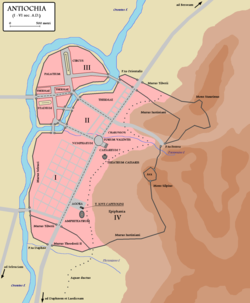You can help expand this article with text translated from the corresponding article in Italian. (September 2025)Click [show] for important translation instructions.
|
| Siege of Antioch (253) | |||||||
|---|---|---|---|---|---|---|---|
| Part of the Roman-Persian wars | |||||||
 Map of Antioch in Roman times. | |||||||
| |||||||
| Belligerents | |||||||
| Roman Empire | Sassanid Empire | ||||||
| Commanders and leaders | |||||||
| Unknown | Shapur I Hormizd I [3] | ||||||
| Strength | |||||||
| Unknown | Unknown | ||||||
The siege of Antioch took place when the Sassanids under Shapur I besieged the Roman city of Antioch in 253 after defeating the Romans in the Battle of Barbalissos. [4]